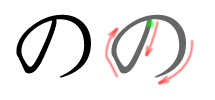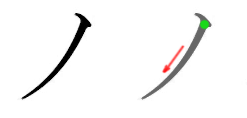No (kana) on:
[Wikipedia]
[Google]
[Amazon]
の, in hiragana, and ノ, in
 To write の, begin slightly above the center, stroke downward diagonally, then upward, and then curve around as indicated by the arrows.
To write の, begin slightly above the center, stroke downward diagonally, then upward, and then curve around as indicated by the arrows. To write ノ, simply do a swooping curve from top-right to bottom left.
To write ノ, simply do a swooping curve from top-right to bottom left.
 の has also proliferated on signs and labels in the
の has also proliferated on signs and labels in the Business' Required to be Registered and Application for Business Registration: Business Name"
Information on ''kana-no'' from ''Nuthatch Graphics''
{{DEFAULTSORT:No (Kana) Specific kana
katakana
is a Japanese syllabary, one component of the Japanese writing system along with hiragana, kanji and in some cases the Latin script (known as rōmaji). The word ''katakana'' means "fragmentary kana", as the katakana characters are derived fro ...
, are Japanese kana, both representing one mora. In the '' gojūon'' system of ordering
Order, ORDER or Orders may refer to:
* Categorization, the process in which ideas and objects are recognized, differentiated, and understood
* Heterarchy, a system of organization wherein the elements have the potential to be ranked a number of ...
of Japanese syllables, it occupies the 25th position, between ね (ne) and は (ha). It occupies the 26th position in the iroha ordering. Both represent the sound . It is highly similar in form to the Kangxi radical
The 214 Kangxi radicals (), also known as the Zihui radicals, form a system of radicals () of Chinese characters.
The radicals are numbered in stroke count order. They are the most popular system of radicals for dictionaries that order Traditi ...
, radical 4.
Stroke order
 To write の, begin slightly above the center, stroke downward diagonally, then upward, and then curve around as indicated by the arrows.
To write の, begin slightly above the center, stroke downward diagonally, then upward, and then curve around as indicated by the arrows. To write ノ, simply do a swooping curve from top-right to bottom left.
To write ノ, simply do a swooping curve from top-right to bottom left.Other communicative representations
* Full Braille representation * Computer encodingsHistory
Like every other hiragana, the hiragana の developed from man'yōgana, kanji used for phonetic purposes, written in the highly cursive, flowing '' grass script'' style. In the picture on the left, the top shows the kanji written in the kaisho style, and the centre image is the same kanji written in the sōsho style. The bottom part is the kana for "no", a further abbreviation. Hentaigana andgyaru-moji
or is a style of obfuscated (cant) Japanese writing popular amongst urban Japanese youth. As the name suggests ( meaning "gal"), this writing system was created by and remains primarily employed by young women.
Like the English phenomenon of ...
variant kana forms of ''no'' can also be found.
Usage
の is a dental nasal consonant, articulated on the upper teeth, combined with a close-mid back rounded vowel to form one mora. In the Japanese language, as well as forming words, の may be aparticle
In the physical sciences, a particle (or corpuscule in older texts) is a small localized object which can be described by several physical or chemical properties, such as volume, density, or mass.
They vary greatly in size or quantity, from s ...
showing possession. For example, the phrase "わたしのでんわ” ''watashi no denwa'' means "my telephone."
In China
 の has also proliferated on signs and labels in the
の has also proliferated on signs and labels in the Chinese
Chinese can refer to:
* Something related to China
* Chinese people, people of Chinese nationality, citizenship, and/or ethnicity
**''Zhonghua minzu'', the supra-ethnic concept of the Chinese nation
** List of ethnic groups in China, people of v ...
-speaking world, especially in Taiwan because of its historical connections with Japan. It is used in place of the Modern Chinese
Standard Chinese ()—in linguistics Standard Northern Mandarin or Standard Beijing Mandarin, in common speech simply Mandarin, better qualified as Standard Mandarin, Modern Standard Mandarin or Standard Mandarin Chinese—is a modern standa ...
possessive marker 的 ''de'' or Classical Chinese possessive marker 之 ''zhī'', and の is pronounced in the same way as the Chinese character it replaces. This is usually done to "stand out" or to give an "exotic/Japanese feel", e.g. in commercial brand names, such as the fruit juice brand 鲜の每日C, where the の can be read as both 之 ''zhī'', the possessive marker, and as 汁 ''zhī'', meaning "juice". In Hong Kong, the Companies Registry has extended official recognition to this practice, and permits の to be used in Chinese names of registered businesses; it is thus the only non-Chinese symbol to be granted this treatment (aside from punctuation marks with no pronunciation value).Inland Revenue Department (Hong Kong)
The Inland Revenue Department (IRD) is the Hong Kong government department responsible for collecting taxes and duties.
History
The Inland Revenue Department was established on 1 April 1947. Initially it administered only one piece of legisla ...
.
References
External links
Information on ''kana-no'' from ''Nuthatch Graphics''
{{DEFAULTSORT:No (Kana) Specific kana